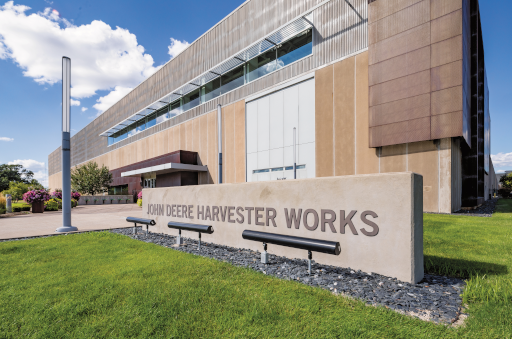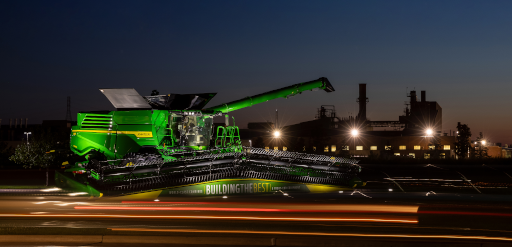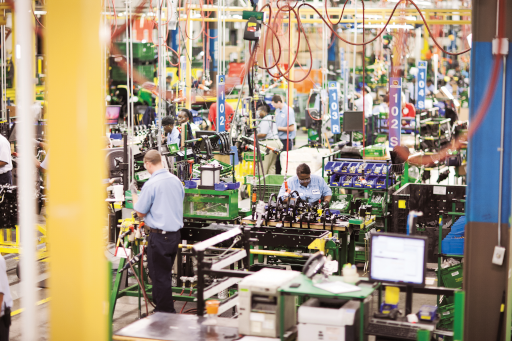John Deere plans to use its new CBRS Priority Access Licenses in five U.S. counties as the fuel for its smart industrial ambitions and deploying 5G. Flexibility on factory floor configuration, support for dense IoT connectivity and the ability to handle large amounts of data securely are some of its top priorities, according to Craig Sutton, manager of manufacturing innovation and technology strategy for John Deere.
The PALs auction raised more than $4.58 billion in gross bids, from an unusually large and diverse field of 271 qualified bidders. Of those, 228 bidders won a total of 20,625 licenses. That’s out of 22,631 available licenses or 7 licenses per U.S. county. Bidders are only allowed to hold a maximum of four PALs per county, and that spectrum can be aggregated. Each PAL consists of a 10 megahertz unpaired channel at 3.55-3.65 GHz. In addition to PALs, 80 megahertz of the 150 megahertz band is available for use under the General Authorized Access (GAA) tier of the CBRS spectrum-sharing framework.
John Deere spent nearly $546,000 for five PALs in five counties, and drew attention as one of a number of non-traditional bidders who sought to acquire spectrum licenses for the first time. It won licenses in Rock Island,
Illinois; Scott County, Iowa; Dubuque, Iowa; Polk County, Iowa; Black Hawk County, Iowa.
Over the years in the lead-up to CBRS Priority Access License auction, as usage of the band was taking shape, Sutton said there were conversations going on within John Deere about its network, technology and connected factory strategies.
“We already know that the limits of broadband, the limit of connectivity, is being pushed inside our factories,” Sutton said. Deere also knew that it was going to continue to push that limit as it connected more and more devices, and collected more data in its factories. “We looked at new use cases coming forth, and we talked through the new use cases, what we kept honing back on is, our connectivity layers are going to be stretched at the rate that we were moving at,” he said. “We decided that taking the opportunity to participate in this auction could be very beneficial to Deere, as we move forward with some of our smart industrial strategies going forward.”
Out of the more than 3,000 counties in the United States for which Priority Access Licenses were available, Deere targeted five. The company has many U.S. locations, Sutton explained, but those five counties are where Deere & Company has some of its largest facilities for manufacturing or operations such as parts warehousing, often with multiple facilities in a county. Still, size wasn’t the only factor.
“We looked at what was available, and those were the five counties that we chose because of the strategic nature of those facilities, on top of the fact that part of the strategy is, these factories are leading a lot of our smart industrial use cases, where we’re looking at adding connected fleets, we’re looking at the impacts of flexibility on our shop floor and moving more and more data to implement facilitate artificial intelligence and machine learning,” Sutton said. “So you put all of these together, where we assessed the fact that we had spectrum availability; we knew we were limited on some of our future going forward on wireless and ethernet cables, and we matched it it together and said, this is the right time to move forward.”
Post-spectrum auction, Sutton said that Deere is already in conversations with strategic partners on how it will move forward on equipment and devices — and that it is already finding places where it will have to lay some groundwork before it can fully utilize CBRS. Sutton gave the example of having to deal with “little pieces” like legacy equipment on the shop floor that was either designed before ubiquitous connectivity or was, at best, designed to be connected to a Wi-Fi network and will have to be migrated in order to connect to CBRS.

“We know that there’s way more to this than the spectrum,” he said. “The hardware sets, the backhaul sets, the networking. … But I would say, from the stance that we’re at today, we do feel as if there’s suitable hardware sets to start us down the path of using the spectrum.”
In terms of its vision for its facilities, John Deere has been talking a lot about the factory of the future, he said, and as the company wrestles with catch-phrases like “smart industrial” and “digital transformation,” it has been leaning into them and trying to figure out what they really mean in terms of evolution.
“This is not the manufacturing of old, with smoke stacks and dirt. When you walk into a John Deere facility today, you do see a large use of robots. You see a large use of computer monitors, digital monitors. Elimination of paper,” he said. “You’ll even see what we’ve started to implement is, camera vision systems that can do quality checks. Mobility on the shop floor, integration into mobile phones — toolsets, apps and things like that.
“You start to see these underpinnings of technology that I don’t think you would’ve seen in many factories and manufacturing setting, just maybe five years ago — especially not ten years ago,” Sutton continued. “So the transformation is definitely happening inside of our facilities. But as we continue to go forward, the one thing I can tell you is that we’re going to connect more devices. There will be more devices and complex types of data being collected.” That includes possibilities such as not only video cameras, but video analytics; audio analytics; virtual models; autonomous mobile robots, all to improve utilization and efficiency.

“As we talk about those, what it comes back to is, how are we going to handle the amount of data that we’re going to need to be moving at a very high rate,” Sutton said. Factories, he said, are like “living, breathing organizations” with materials being constantly moved, people moving and humans and machines interacting. Decisions have to be made quickly; safety protocols have to be maintained. As more devices are connected and more complex data becomes available, he said, Deere knows its current network capabilities will hit a breaking point — and it sees CBRS spectrum is integral to supporting the capabilities that the company wants for its smart factories of the future.
The company plans to start with LTE deployments, but 5G is already top of mind. Sutton said that the company has already been starting to work with CBRS under GAA availability, but plans to start with network pilots in its facilities once it has its licenses officially in-hand in 2021. Within 12-13 months, in 2022, it expects to be pushing broader availability in its locations.
Jahmy Hindman, John Deere CTO, said in a statement that “Implementing 5G in our manufacturing facilities allows John Deere to make significant progress in our smart industrial strategy by turning factories into smart and connected manufacturing facilities – a critical piece of the industrial IoT.” The company described its manufacturing facilities as “extraordinarily complex environments that rely on automation and connectivity,” that have “miles of embedded Ethernet cables connecting Wi-Fi drop points currently in factory ceilings.” But, the company said, that scenario means limited flexibility for set up and upgrades, and “5G enabled by private networks will allow John Deere to design a more flexible, nimble and connected facility, creating opportunity for further advancement and greater efficiency that will transform the manufacturing process.” It also referenced expanding its ability to leverage edge computing, autonomous devices and “a larger set of smart applications like real-
time location systems, asset tracking, inventory management, wearables, building automation, and robotics for operational cost savings.”
While the question has been raised within the company of whether spinning up CBRS-based systems will mean turning off Wi-Fi, Deere doesn’t plan to make any switch-flip transitions.
“We see this augmenting Wi-Fi,” Sutton said. “We know that our Wi-Fi networks have limitations,” he said, but Deere also knows that those networks will also still see significant use for some scenarios. “We’re going to see how they work together and how they augment each other.” Long-term, he said, transitioning more high-priority or high-security workloads onto 5G over CBRS could open up additional capacity on the Wi-Fi networks for different workload types. “We see that coming together as a kind of technical partnering process that work with each other knowing that we’ll probably phase our loads one direction.”
Sutton said that when it comes to the question of handling the CBRS networks in-house versus a network-as-a-service model, Deere will do a combination. Each of the facility locations has existing IT integrators that are familiar with serving the needs of complex enterprise locations. But, he says, “we’re not naive to the fact that we know that this is not only new territory, but the space in changing quickly also.” That doesn’t just apply to the pure cellular technology landscape, Sutton said, but also to how Deere will approach cybersecurity and how to carry the level of protection it expects, into a more highly connected world. So the company’s IT and cyber teams are already involved and it is talking to its integrators and other strategic partners on how to set things up securely and efficiently.
Asked about how being a CBRS spectrum owner is changing Deere’s relationship with cellular carriers, Sutton said that those relationships are deepening.
“We have actually had some really good discussions with several major cellular companies about how we work together with this going forward,” he said. With the results of the auction public, it’s no secret that the company is now a PAL holder and has a CBRS strategy. “Most of these companies have multi-technology strategies and that’s been the positive, that we can talk in these five counties about how the strategy is going to look for CBRS spectrum.” Where Deere has spectrum, he says, the company can bring that to the table — maybe the carriers bring infrastructure or maintenance to a partnership. And there are still many U.S. Deere locations where the company doesn’t own spectrum, and it will still need to partner with carriers and infrastructure vendors to serve those locations. So rather than spectrum ownership closing Deere off from carrier relationships, Sutton said, “It’s probably driving us into deeper, positive conversations about how we can do this and where it’s a benefit for all parties involved to provide competitive advantages to Deere as a manufacturer.”

